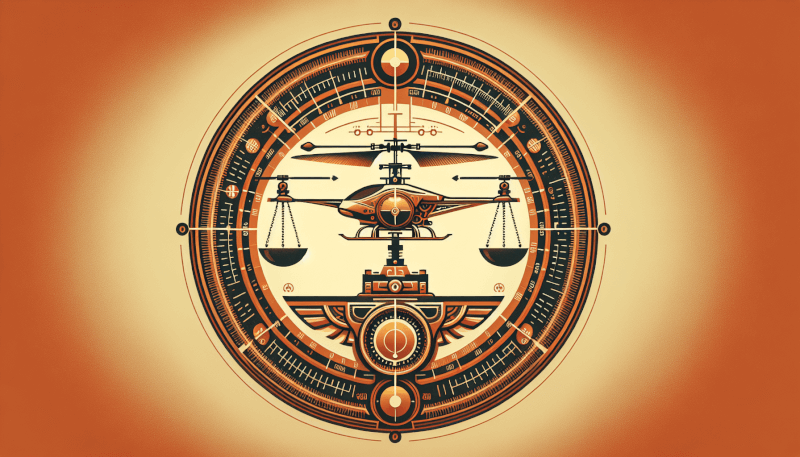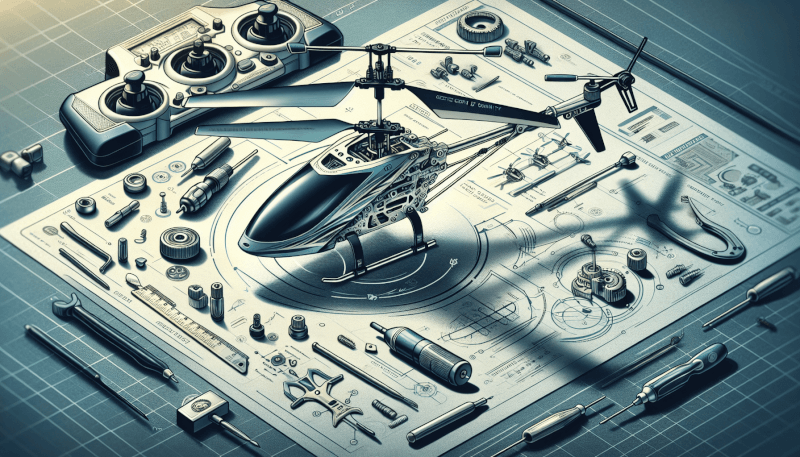Are you ready to take your RC heli flying skills to the next level? One key factor that can greatly affect the performance and stability of your remote control helicopter is the center of gravity. Getting the center of gravity perfectly balanced is crucial for optimal flight control. In this article, we will guide you through the simple and effective steps to adjust your RC heli’s center of gravity, ensuring that you achieve smooth and controlled flights every time. So, grab your RC heli and let’s get started on achieving the perfect balance!
Understanding Center of Gravity
What is center of gravity?
The center of gravity (CG) is the point on an object where the gravitational forces acting on it can be considered to be concentrated. In the context of RC helicopters, it refers to the specific point where the helicopter is in perfect balance, allowing it to maintain stability and maneuverability in the air.
Why is center of gravity important in RC helis?
The center of gravity plays a crucial role in the flight characteristics of an RC helicopter. Having the correct CG is essential for maintaining stability and control during flight. If the CG is off, the helicopter may become difficult to control, resulting in erratic flight behavior, poor maneuverability, or even crashes. Therefore, understanding and properly adjusting the center of gravity is vital for ensuring a safe and enjoyable flying experience.
Effects of improper center of gravity
Having an improper CG can have various detrimental effects on the performance of an RC helicopter. If the CG is too far forward, the helicopter may tend to pitch forward excessively, making it difficult to control and increasing the risk of nosedives. Conversely, if the CG is too far back, the helicopter may become tail-heavy, causing instability and making it challenging to maintain a level flight.
Locating the Center of Gravity
Checking manufacturer’s instructions
When it comes to determining the center of gravity of an RC helicopter, it is always recommended to consult the manufacturer’s instructions. These instructions often provide specific guidance on where the CG should be located for optimal performance. Following the manufacturer’s recommendations ensures that the helicopter operates as intended and minimizes the risk of encountering problems during flight.
Using a CG balancer
A CG balancer is a helpful tool that assists in finding the correct center of gravity for your RC helicopter. It typically consists of two support arms that allow you to suspend the helicopter in a balanced position. By adjusting the position of the helicopter until it remains level on the CG balancer, you can accurately determine the correct CG point. CG balancers are widely available and can be a valuable addition to any RC helicopter enthusiast’s toolkit.
Marking the center of gravity
Once you have determined the correct center of gravity, it is essential to mark it on your RC helicopter. This can be done using a small piece of tape or a waterproof marker. Marking the CG serves as a visual reference point and helps you ensure that the helicopter’s weight distribution remains consistent over time. It makes future adjustments and fine-tuning much easier and ensures that you always know the correct location of the CG.

Adjusting the Center of Gravity
Adding or removing weight
One of the most effective ways to adjust the center of gravity is by adding or removing weight from the helicopter. If the CG is too far forward, adding weight to the tail section can help shift the balance toward the rear. On the other hand, if the CG is too far back, adding weight to the front can help correct the balance. It is important to note that when adding or removing weight, it should be done gradually and carefully to avoid sudden and drastic changes in the CG.
Moving battery position
In RC helicopters, the battery position has a significant impact on the center of gravity. Moving the battery forward or backward can help fine-tune the CG to achieve the desired flight characteristics. If the helicopter tends to be nose-heavy, moving the battery toward the tail can help correct the balance. Conversely, if it is tail-heavy, moving the battery closer to the nose can help restore stability. Experimenting with different battery positions and observing their effects on the CG can lead to improved flight performance.
Adjusting rotor blade alignment
The alignment of the rotor blades also affects the center of gravity in RC helicopters. Proper blade alignment is crucial for maintaining balance during flight. If one blade is heavier or has a different angle than the other, it can create an imbalance, leading to stability issues. By adjusting the pitch or tracking of the rotor blades, you can fine-tune the center of gravity and improve the overall flight characteristics of the helicopter.
Testing and Fine-Tuning
Performing a test flight
After making adjustments to the center of gravity, it is important to perform a test flight to evaluate the helicopter’s behavior. During the test flight, pay close attention to how the helicopter handles, whether it maintains stability, and if it responds to control inputs as expected. Take note of any changes in flight characteristics compared to before the adjustments were made.
Observing helicopter stability
While test flying, observe the stability of the helicopter in various flight maneuvers. Check if it tends to level itself out when hovering or if it drifts to one side. Take note of any excessive pitching or rolling tendencies. These observations will help you identify whether further adjustments to the center of gravity are needed to achieve optimal stability and control.
Making further adjustments
Based on the observations made during the test flight, you may need to make further adjustments to the center of gravity. If the helicopter still exhibits undesirable flight characteristics, consider fine-tuning the weight distribution or battery position to achieve a more balanced CG. By repeating the process of adjusting, testing, and observing, you can gradually optimize the center of gravity to achieve the best possible flight performance.

Factors Affecting Center of Gravity
Battery size and weight
The size and weight of the battery used in an RC helicopter significantly influence the center of gravity. Heavier batteries will naturally shift the CG toward the bottom of the helicopter, while lighter batteries may cause it to move upward. Additionally, larger batteries may require adjustments in the battery position to maintain optimal CG. Consider these factors when choosing and installing a battery to ensure that the CG remains within the desired range.
Rotor blade length and weight
The length and weight of the rotor blades also have an impact on the center of gravity. Longer and heavier blades can shift the CG outward, affecting the balance of the helicopter. It is important to ensure that the rotor blades are of equal weight and that their lengths are consistent. Any variations in blade weight or length should be taken into account when determining the center of gravity and making adjustments to achieve an even weight distribution.
Modifications and upgrades
Modifications and upgrades to an RC helicopter can alter its weight distribution and, consequently, the center of gravity. When adding or changing components such as motors, receivers, or servos, it is essential to consider their weights and their impact on the overall balance of the helicopter. Keep in mind that modifications may require readjusting the center of gravity to account for any changes in weight caused by the upgrades.
Safety Considerations
Checking for loose components
Before every flight, it is crucial to check for any loose components that may affect the center of gravity. Ensure that all screws, bolts, and connections are securely tightened. Loose components can create imbalances and compromise the helicopter’s stability and control. Regular maintenance and thorough inspections are essential to prevent any unforeseen issues that may arise while flying due to loose or shifting parts.
Securely fastening added weights
When adding weights to adjust the center of gravity, it is necessary to ensure that they are securely fastened to the helicopter. Loose or unsecured weights can shift or detach during flight, leading to unexpected changes in the CG and potentially causing instability or dangerous situations. Always double-check that any added weights are properly secured and will not become loose during flight.
Avoiding extreme adjustments
While adjusting the center of gravity, it is important to avoid making extreme changes all at once. Gradual adjustments allow for better control and understanding of the effects on the helicopter’s flight characteristics. Making drastic adjustments can lead to unpredictable flight behavior and may increase the risk of crashes or loss of control. Take a systematic approach and make small, incremental changes to achieve the desired CG.

Tips for Optimizing Performance
Finding the ideal center of gravity
Finding the ideal center of gravity for an RC helicopter requires patience and experimentation. Take the time to fine-tune the CG by making small adjustments and thoroughly testing the helicopter’s performance after each change. By striving for an optimal CG, you can achieve improved stability, control, and maneuverability, resulting in a more enjoyable flying experience.
Balancing different flying styles
Different flying styles may require slight variations in the center of gravity to suit specific needs. For example, a more aggressive and aerobatic flying style may benefit from a slightly forward CG to enhance responsiveness and maneuverability. On the other hand, a more stable and scale flying style may favor a slightly aft CG for smoother and more realistic flight characteristics. Experiment and adjust the CG to match your preferred flying style for optimal performance.
Recording successful configurations
To streamline the process of finding the optimal center of gravity, it can be helpful to keep a record of successful configurations. Take note of the adjustments made, the corresponding flight characteristics, and any other relevant observations. This record will serve as a reference for future adjustments and troubleshooting, ensuring consistency and efficiency in optimizing the CG for different scenarios or when making changes to the helicopter.
Common Mistakes to Avoid
Ignoring center of gravity
One of the most common mistakes made by RC helicopter pilots is disregarding the importance of the center of gravity. Neglecting to find and adjust the CG can lead to unstable flight characteristics, poor control, and increased risk of accidents. It is vital to prioritize understanding and adjusting the center of gravity to ensure safe and enjoyable flights.
Adding excessive weight
While adding weight can be an effective way to adjust the center of gravity, it is crucial to avoid adding excessive weight. Excessive weight can negatively impact the overall performance and flight time of the helicopter. Strive for a balanced weight distribution while keeping the helicopter as lightweight as possible. Consider other methods of adjusting the CG, such as fine-tuning the battery position or rotor blade alignment, to achieve the desired balance without unnecessarily increasing the weight.
Making sudden adjustments
Making sudden and drastic adjustments to the center of gravity without proper testing and observation can lead to unpredictable flight behavior and compromised safety. Always take a gradual approach when adjusting the CG, making small changes at a time and thoroughly evaluating the helicopter’s performance after each adjustment. This systematic approach allows for better understanding of the effects and more precise fine-tuning for optimal flight characteristics.

Seeking Expert Advice
Joining RC heli communities
Becoming part of RC heli communities is a great way to connect with experienced pilots and gain valuable insights into adjusting the center of gravity. Online forums, social media groups, and local RC flying clubs often have knowledgeable members who are willing to share their expertise and provide guidance. Engaging with these communities can help you expand your knowledge, learn from the experiences of others, and receive personalized advice for your specific RC helicopter model.
Consulting experienced pilots
If you have the opportunity, consult experienced RC helicopter pilots who have a deep understanding of adjusting the center of gravity. These individuals can provide valuable tips, recommendations, and firsthand knowledge based on their own experiences. Seeking advice from experts allows you to tap into a wealth of knowledge and expertise, ensuring that you make informed decisions when it comes to optimizing the center of gravity for your RC helicopter.
Attending RC heli events
Attending RC heli events, such as fly-ins, competitions, or workshops, provides an excellent opportunity to immerse yourself in the world of RC helicopters and seek guidance from experts. Interacting with professional pilots and participating in workshops or seminars dedicated to CG adjustments can broaden your understanding and provide hands-on learning experiences. By actively engaging in RC heli events, you can gain valuable insights and receive direct feedback on your own CG adjustments.
Conclusion
Understanding and properly adjusting the center of gravity is crucial for achieving optimum performance and a better overall flying experience with your RC helicopter. By following manufacturer’s instructions, using a CG balancer, and marking the CG, you can locate the correct center of gravity. Adjustments can be made by adding or removing weight, moving the battery position, or adjusting rotor blade alignment. Through testing, observation, and making further adjustments, you can fine-tune the CG to achieve stability and control. Factors such as battery size, rotor blade length, and modifications or upgrades also affect the CG. Safety considerations include checking for loose components, securely fastening added weights, and avoiding extreme adjustments. Tips for optimizing performance include finding the ideal CG, balancing different flying styles, and recording successful configurations. Finally, seeking expert advice through RC heli communities, experienced pilots, and attending events can further enhance your knowledge and understanding of adjusting the center of gravity. With continuous fine-tuning, you can enjoy a better flying experience with your RC helicopter.



